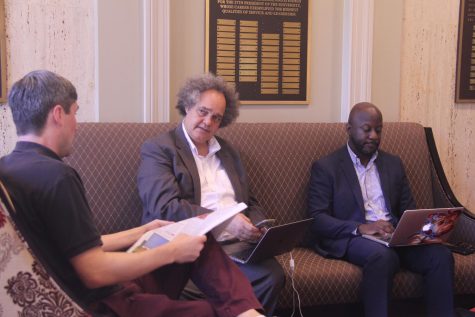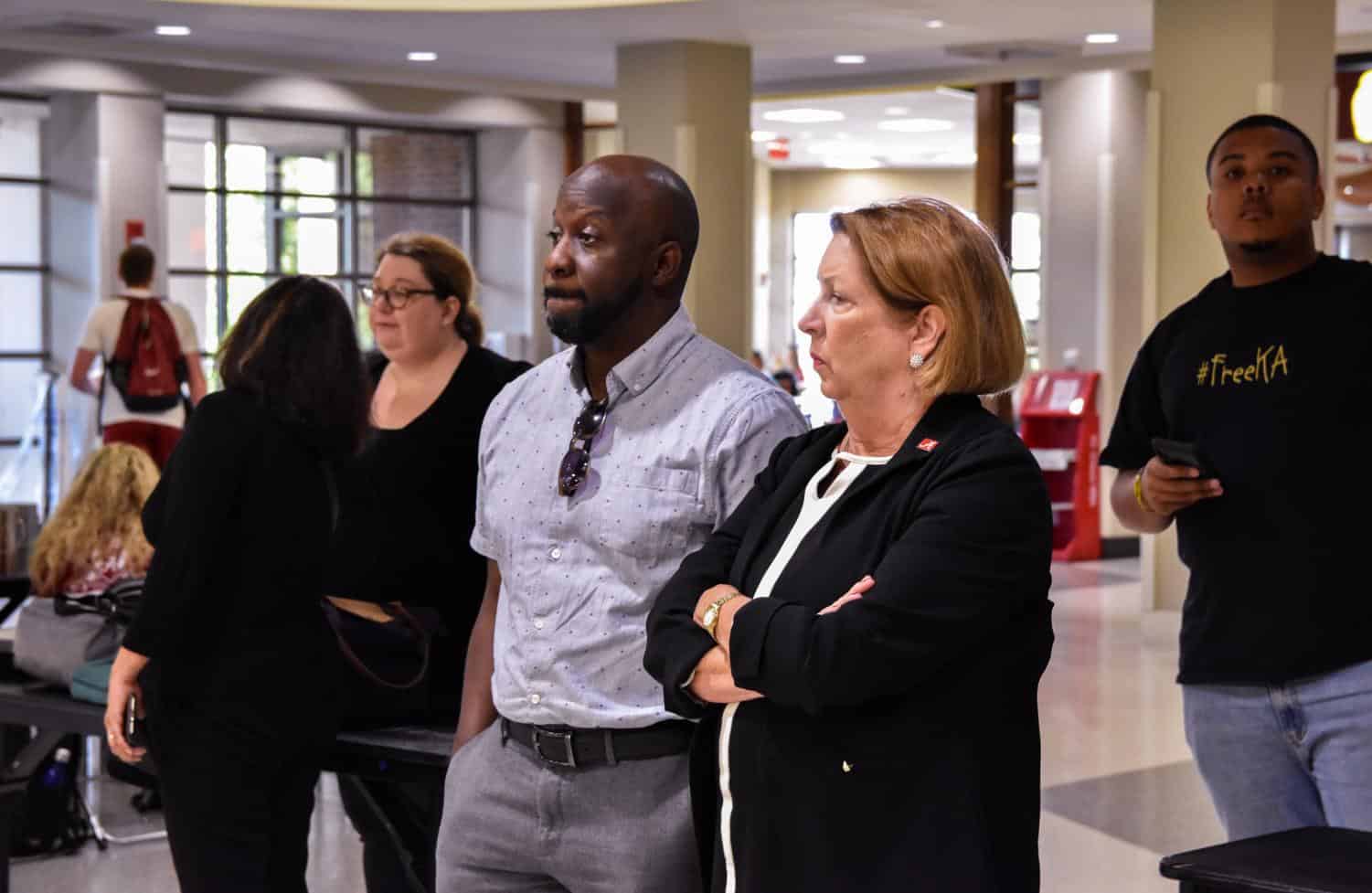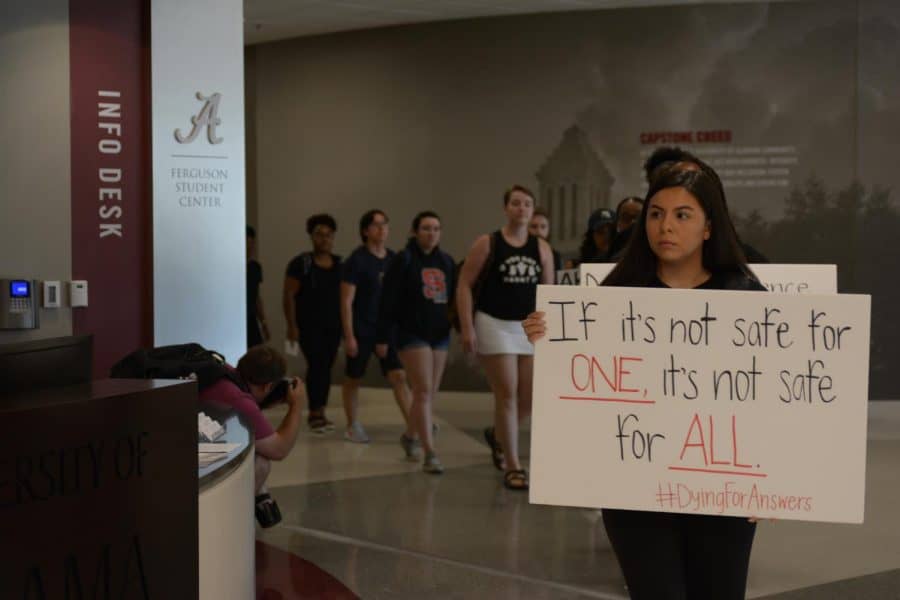A month after Riley’s resignation, demonstrations continue
October 10, 2019
The past month at the University has been wrought with discussion and demonstrations about racism and inequity on campus, but according to several students and faculty, administrative action is slow-going.
A series of town halls, closed and open meetings, protests and social media campaigns came after the Sept. 5 resignation of former dean of students Jamie Riley, whose past tweets surfaced on Breitbart News a day before.
[READ MORE: Members of the UA community ask for an end to the silence and ‘Only the beginning:’ Activists push for a more inclusive campus]
While University leaders have been hosting public listening sessions and closed-door meetings, however, several say that there is much more to be done. Over the past two weeks, that message has remained clear, both in the open expanse of the Ferguson Center and in the close quarters of the Rose Administration lobby, as demonstrators have made sure to keep conversations about institutional racism, safety, academic freedom, and diversity, equity and inclusion alive.
#DYINGFORANSWERS
Last week, about 35 UA students gathered in the Ferguson Student Center, where they all then laid on the ground motionless to mimic dead bodies, a form of demonstration called a “die-in.”
Demonstrators were asked not to speak during the die-in; rather, participants were given a piece of paper to explain the purpose of the protest. Various faculty, staff and administration members stood to the side to observe the die-in.
The paper read that the demonstration was meant to symbolize “the exhaustion of being a marginalized student on this campus. We are not welcomed. We are not safe. We are not valued.”
“Are you tired of not having space on campus where you feel comfortable? Do you feel isolated on The University of Alabama’s campus? Do you feel safe on campus? Have you been discriminated against? Do you even feel heard by the administration? #DyingforAnswers”
Carina Villarreal, a senior public relations major and one of the organizers of the die-in, said that former dean of students Jamie Riley’s resignation served as a catalyst for the unrest on campus over the last month but that the issues they are addressing existed on campus before Riley resigned.
“Obviously the catalyst was everything that was going on with the previous dean and forced resignation, but this is really just us trying to get a united front and change the student culture at UA,” Villarreal said.
Various forms of demonstrations have taken place in the aftermath of Riley’s resignation. The option of a die-in for last week’s demonstration was selected because of the shock value it has been associated with, according to Villarreal.
“It is very provocative, but it actually symbolizes the exhaustion of being a minority student on campus and not always getting our voices heard, having to be a social justice advocate and a student at the same time,” Villarreal said.
Though the University has met some of the demands that have been put forth to create a campus culture that is welcoming for all, Villarreal envisioned a longer fight ahead and was adamant that students will continue to organize if necessary.
“If this continues to be a problem on this campus, I believe that our generation is fully equipped to think off the top of our head and fight for the things that we think we deserve on campus, especially at a public university,” Villarreal said. “So if it’s transparency, if it’s just safety in general, I think we’re fully equipped to fight for those things, and I don’t think this is a fight that’s gonna stop anytime soon.”
JoJo Rice, a senior majoring in criminal justice, said the group of twelve students who organized the protest met at the beginning of September to start brainstorming.
“We just racked our brains on how to get administration’s attention, to get the student body’s attention, because it’s about more than just administration,” Rice said. “It’s an Alabama thing.
“This is a demonstration. We don’t have any demands or any things we’re looking for out of this other than attention. Not bad attention. Attention that is going to make administration look and say, ‘These are our students and they don’t feel comfortable here. How can we make them feel comfortable?’”

THE WORK-IN
Throughout the past month, several meetings have been taking place behind closed doors and out of the public eye. To bring visibility to those continued conversations and a perceived lack of action on behalf of administration, members of the Black Faculty and Staff Association spearheaded a “work-in” in the Rose Administration building, which started on Thursday, Oct. 3, and will continue until further notice.
The work-in comes on the heels of a social media campaign by the organization, which sought to raise awareness about their demands that have not been met by administration, following a letter from BFSA that was sent to Bell on Friday Sept. 13.
CW staff reporter Jeffrey Kelly interviewed BFSA president Andre Denham earlier this week about the goals of these continued demonstrations. You can read the Q&A below.
Q: With this sit-in, what is the message that you’re trying to convey?
A: Well, we call it more of a work-in because we’re asking everyone to bring something to work on; whether it’s grading papers or a book you need to be reading or a manuscript you’re working on. The message that we’re trying to say is that based on the letter that we sent to the president and the responses that we received back, there are still some things that we are concerned about and we want to make sure that the administration understands, and I believe they do, that those concerns aren’t going to fade away as time goes on that we want to continue the conversations that we are having and moving toward- moving the campus forward from this incident and we feel that this is a good way of doing that.
Q: Can you discuss the letters and the responses?
A: The letter that we sent is on our social media platforms you can find it on Instagram, Twitter, I believe it’s on Facebook as well. I will say that some of the concerns have been addressed.
One was related to the Vice President of Student Life search, the composition of the committee, the transparency surrounding the search that’s been addressed; there’s a website up now, BFSA [Black Faculty and Staff Association] has a representative on that committee.
The other concern was related to academic freedom and free speech, and we had asked for the president to publicly reaffirm the university’s stance on those two things. He did so in two ways that I know of one in his letter to us, which is a public-facing letter; the letter was to BFSA and, also, in the fall campus assembly, he said it as well.
Our other concerns are, and it’s a bit more detailed in the letter, but in general, one of our main concerns is that incidents like this that happen on our campus make it difficult for the university to recruit and retain a diverse student and faculty and staff. So, we want to know what the university’s response is going to be? What is the strategy going forth to repair their national reputation, and if you look in our letter, we say, you know, it’s a recurring damage to our national reputation. So, what’s going to be the university’s strategy to change that narrative around the University of Alabama because it’s hard to recruit nationally when you have these things pop up on what it seems like a regular basis surrounding our school.
Another concern we had was the Office of Diversity, Equity, and Inclusion, and it was really just trying to understand what exactly— it’s a new position, it’s a new division, so getting more clarity on what the portfolio is of that. So basically, what institutional oversight does that division have; making sure that that division has the resources it needs to do the work that it needs to do.
Another concern was related to EEO Equal [Employment] Opportunity Office here and Title IX, and we had some concerns about where those two compliance offices were located in terms of the organizational structure.
And then the last concern, which is kind of related to all of it and kind of sums it up, is that there was a consensus among BFSA members that the environment on the campus had become the word that we used was “toxic” and that we were concerned. All of these concerns kind of, you know, surround that particular one, and so what’s the university going to do to change the climate and environment on campus?
Q: What are you looking for, in terms of a result?
A: There are some things that we’ve been in conversation with that would provide— there are some things that take a while, right. There are some immediate, some intermediate, and some long-range things that we would look— In essence I’d sum it up we are looking for some action from the university that provides on a public level that shows they are acting in good faith to address the concerns that we have and to start the process of healing the university and taking us to where we know we should be and we know where we could be. So, it’s a variety of things, so right now, immediately, we’re looking for some tangible evidence that the university is taking the steps that it needs to start the process of healing.
Q: How did BFSA come up with the idea of the work-in?
A: Well, as I said, we knew that we wanted to keep the conversation going, so it was just at a meeting. We are primarily asking faculty to do it because staff on campus their schedules aren’t necessarily as flexible as ours, and then for staff on all university campuses, they aren’t necessarily as protected as faculty members are. So, those were the two main things, but it was just sitting around strategizing on how we can keep the conversation going.
Q: With everything that has been happening on campus, how has the dynamic and environment for faculty and staff of color changed on this campus?
A: I don’t know if I can speak for everyone; that’s a big one. I think it just makes folks, and if I can speculate, I think that for some folks, it hasn’t changed. The situations that they’re in they might not feel that it’s any different because of this, and I can also speculate that there are some other folks who might be feeling unhappy being here at UA; they’re not really pleased with what’s going on. They could be frustrated they could be a lot of things, so like I said, I think for some folks, it might be the same, and for other folks, they just aren’t feeling very happy here right now.
Q: How has the response been to the work-in?
A: We’ve actually got widespread response and support from across campus. We kind of dipped our toes in the water to see how it would go, but we’ve got a pretty good response from it. We’ve actually been able to have a lot of really good conversations because it’s a high traffic area in Rose [Administration Building]. So, quite a few people have stopped by and talked to us about what’s going on, and that’s where I’ve been kind of able to see that there is support for the concerns that BFSA has.
I haven’t heard a negative thing about it. The administration has been very okay with us being here; they’ve brought down water we had donuts one day, so I think overall campus-wide from what I can hear and what I’ve heard is that it’s fine.
Q: How did you get the word out about the work-in?
A: We have a mailing list. So we sent an email out to everyone that’s on the mailing list, and that got forwarded around as well to folks that are not necessarily on the mailing list.
Q: How can students show their support and get involved in this?
A: I’m asking students to email me to see how we can do that right now we’re doing just faculty, but if students want to stop by and talk and learn more about that we’re here. I think this week somebody will be here from 8 to 2 every day this week. But yeah, for students they can support and also once you’ve come back and chatted and learned more about it go back and spread the word within your peer groups that BFSA is concerned because we are concerned, and our primary concern are students.
That’s the primary focus of our mission it is the primary focus of the university so we want to make sure that the students, faculty, and staff are in a climate that is receptive to their needs that’s welcoming that’s a place where they want to be at, and they feel like they can be a part of the larger institution and also they can like retweet share all that stuff that helps out a lot.
Q: How long will the work-in be?
A: All this week, and we’re working on next week.
Q: Has time been crucial for this movement?
A: With things like this, I think that time is always crucial. You want to keep the momentum going, right, and what tends to happen is the further you are from the catalyst for something like this, the people kind of move on. So that’s why we’re kind of doing it on a couple of fronts; we’re counting up on social media, but we’re also here in person in Rose to try to make sure the conversation is still going on so that time doesn’t become something that’s a detriment to getting our concerns addressed.
ANOTHER EMAIL
After weeks of pressure from students, staff and faculty, and five days after the first work-in, President Bell announced the Advisory Committee to Support Diversity Goals on Tuesday, Oct. 8.
“We have made progress on this campus in many ways, but we still have much we can and must do,” Bell said in a press release from UA News. “I look forward to the work of this committee and to the impact it will make on the future of this great University.”
According to the press release, the committee will begin meeting this month. A website will provide regular updates to the campus community about the committee’s efforts, activities and accomplishments.
The committee consists of faculty, staff and students: Harrison Adams, Student Government Association president; Ben Bickerstaff, Professional Staff Assembly president; Dr. André Denham, Black Faculty and Staff Association president; Dr. Rona Donahoe, Faculty Senate president; Matt Fajack, vice president for Finance and Operations; Demarcus Joiner, SGA vice president for diversity, equity and inclusion; Dr. Stacy Jones, associate dean of students; Layne Lightfoot, Honors College student representative; LeNá McDonald, project coordinator in the President’s Office; Angel Narvaez-Lugo, president of the Office, Clerical & Technical Staff Assembly; Dr. Christine Taylor, vice president for Diversity, Equity and Inclusion and committee chair; Chad Tindol, chief administrative officer; and Dr. Kevin Whitaker, executive vice president and provost.
Out of the 13 individuals on the committee, none of them are Asian, Middle Eastern, Pacific Islander or Native American, or anyone born outside the U.S.
As of Thursday, only two of BFSA’s specific demands have been met. But Denham said the committee was a move in the right direction.
“I am looking forward to working with the others on the committee to quickly deliver to the campus concrete, impactful and measurable actions the University will take to accelerate the pace at which we move toward inclusive excellence,” Denham said.
A TIMELINE OF EVENTS
To guide readers through a month of headlines, The Crimson White created a timeline of significant events. These events are only those that were made public or known to us. If you notice anything missing from this timeline that The Crimson White should include, contact us at newsdesk.thecrimsonwhite.com.
- Sept. 4 – Breitbart article is published
- Sept. 5 – Officials confirm Riley’s resignation
- Sept. 6 – Student affairs professional in Tennessee and former prospective student pens letter to UA administration, claiming that UA wasn’t made for him
- Sept. 12:
- 8 a.m. – Open letter with 533 signatures sent to UA administrators, deans and news outlets to demand affirmation of free speech
- 3 p.m. – Provost Whitaker announces plans to retire in 2020
- 5 p.m. – BFSA leads an open meeting to discuss concerns
- 6 p.m. – SGA holds a town hall to discuss DEI on campus
- 6:30 p.m. – The SGA Senate passes a resolution to affirm free speech on campus, but guts clauses mentioning Riley’s name
- Sept. 13 – BFSA sends letter to President Bell with six demands, SGA announces diversity certification program and multicultural cabinet
- Sept. 17:
- 8 a.m. – Graduate students stage sit-in until they secure a meeting with Bell
- 3:20 p.m. – Message from the President is sent to UA community
- 3:30 p.m. – Faculty Senate creates task force to change campus culture
- Sept. 18 – Change Is Now march is announced with time change
- Sept. 19:
- 3:30 p.m. – Over 100 students march from Dean of Students office to Rose Administration building to address administrators
- 6:30 p.m. – SGA Senate passes free speech resolution in full
- Sept. 23 – UA publicly announces search committee for VP of Student Life
- Sept. 24 – BFSA launches social media campaign after only one demand is met
- Sept. 27 – BFSA receives written response from Bell, GRS graduate students send demands to Kathleen Cramer and G. Christine Taylor with two-week deadline
- Oct. 1 – Students stage die-in
- Oct. 2 – President Bell affirmed campus free speech and academic freedom at the Fall Campus Assembly, now meeting two BFSA’s six demands
- Oct. 3 – BFSA stages work-in, United Campus Workers of Alabama sends letter to President Bell
- Oct. 8 – UA publicly announces advisory committee to support DEI efforts
CW reporters Javon Williams, Keely Brewer and Audrey Harper contributed to the reporting of this story.
Editor’s Note: This story was updated on Thursday morning to include a timeline and other stylistic changes.


